Ever wondered if your Norwegian Forest Cat, with its wild heritage, can actually enjoy a walk on a leash? It’s not only possible but also incredibly rewarding! According to feline behaviour consultant Anita Kelsey, harness training your Norwegian Forest Cat can transform your furry friend’s outdoor experiences. But how do you go about it successfully?
Anita suggests starting as young as possible and emphasizes that patience and perseverance are key. It’s crucial to respect your cat’s personality—if your furball shows major distress, it’s time to hit pause. Familiarizing your cat with the harness during playtime, gradually introducing it, and using treats and meal times as positive reinforcement can make the process smoother. Ensuring a proper fit is essential, and once your cat adapts, using an extendable lead can offer them more freedom to explore.
Ready to embark on this journey with your Norwegian Forest Cat? Let’s dive into the tips that can make harness training a breeze!
Key Takeaways
- Start harness training your Norwegian Forest Cat as early as possible.
- Patience and perseverance are key in the training process.
- Respect your cat’s personality and stop if they show major distress.
- Familiarize your cat with the harness during daily playtime.
- Use treats and meals as positive reinforcement.
- Ensure the harness fits properly for safety and comfort.
- Consider using an extendable lead for more exploration freedom.
Why Harness Training is Beneficial for Your Norwegian Forest Cat

Imagine your Norwegian Forest Cat gracefully strutting through the great outdoors – not as a lone wanderer chasing birds, but safely under your watchful eyes. The benefits of outdoor exploration for your feline can’t be overstated. Unleashing that inner adventurer means fulfilling natural instincts in a secure environment, which in turn, promotes physical and mental stimulation for cats.
Outdoor adventures aren’t just a treat; they are also a fountain of unparalleled physical exercise. Getting your cat to jog alongside you or pounce on a stray leaf ensures they expend pent-up energy. This physical activity can lead to better sleep patterns and a noticeable decrease in those undesirable behaviors that often stem from cabin fever.
Harness training is a golden opportunity to foster a deeper connection with your four-legged companion. Through shared experiences, from picking out the perfect harness to embarking on mini expeditions, you and your cat build an unshakeable bond. Trust me, nothing spells trust-building like working together on mastering those first few steps outside!
One can’t overlook the aspect of safety. Harness training equips you with a tool to allow safe outdoor adventures for cats. You’re essentially offering your cat a VIP pass to the environment while keeping potential hazards at bay. All the wonders of the outside world become a controlled and enriching playground, leaving both you and your cat happier and more content.
Choosing the Right Harness for Your Norwegian Forest Cat
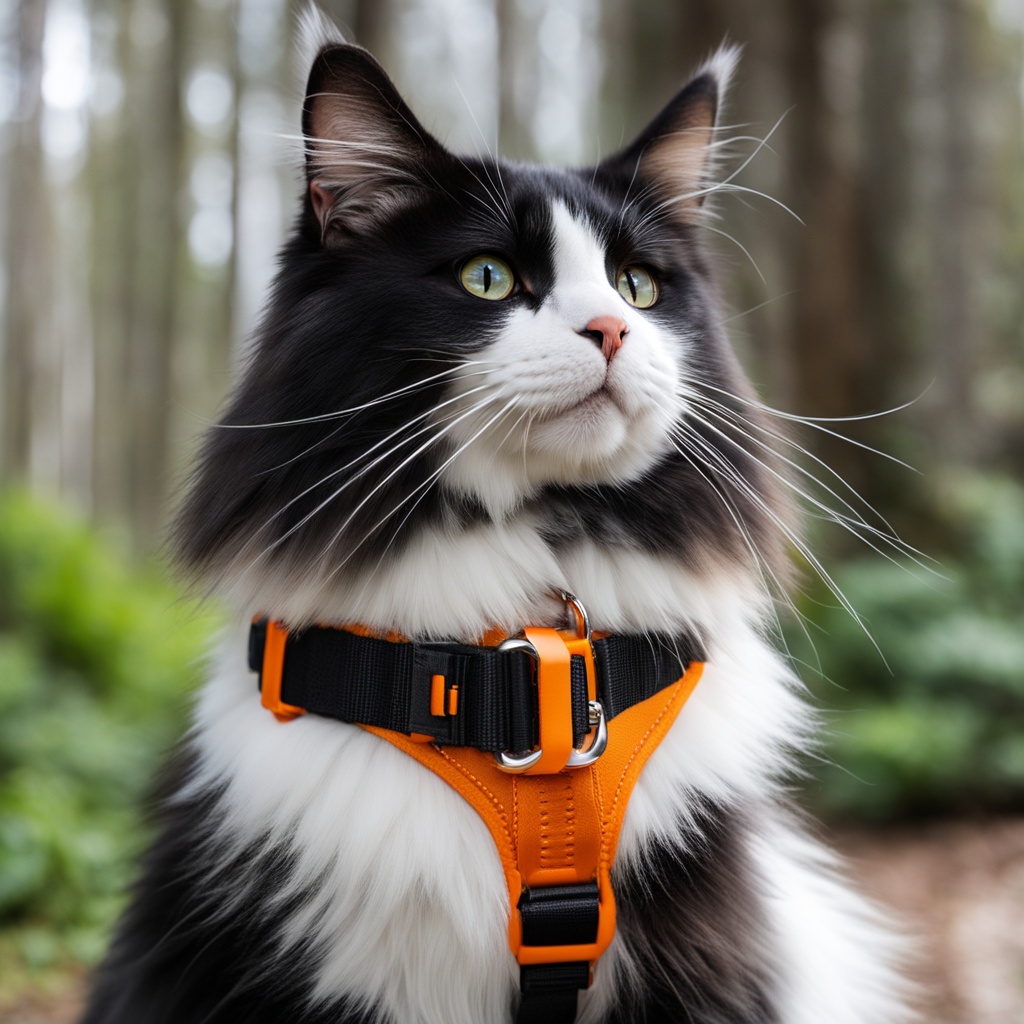
Choosing the appropriate harness for your Norwegian Forest Cat is vital to ensure both comfort and safety while training a cat to walk on a leash. Various types of cat harnesses are designed for different needs and preferences. Selecting the right one will not only enhance their outdoor experience but also make the process smoother.
Types of Cat Harnesses
Understanding the types of harnesses available can help you make an informed choice. Common options include the H-style cat harness, Figure-eight cat harness, and vest harness for cats. Each type offers unique benefits, with the H-style providing adjustability, the Figure-eight enhancing security, and the vest harness distributing pressure evenly.
| Type of Harness | Benefits | Drawbacks |
|---|---|---|
| H-style Cat Harness | Adjustable, easy to put on | May be easier to escape from |
| Figure-eight Cat Harness | More secure fit, prevents escape | Can be trickier to put on |
| Vest Harness for Cats | Even pressure distribution, comfortable | May feel bulky, tricky to size |
How to Measure Your Cat for the Perfect Fit
Getting the right measurements ensures the harness fits well and is comfortable. Start by measuring your cat’s chest girth right behind the front legs. The key cat harness tips include ensuring you can fit one or two fingers between the harness and the cat to avoid tightness and discomfort while ensuring it is snug enough to prevent slipping out.
Best Materials for Cat Harnesses
The best materials for a harness are those that are soft, comfortable, and non-irritating. Materials like breathable mesh and padded nylon are highly recommended. Keep in mind that materials should also be durable enough to withstand the cat’s outdoor adventures while being easy on their fur and skin.
By considering these cat harness tips, you can set the foundation for successful training and enjoyable outdoor experiences for both you and your Norwegian Forest Cat.
How to Train a Norwegian Forest Cat to Use a Harness
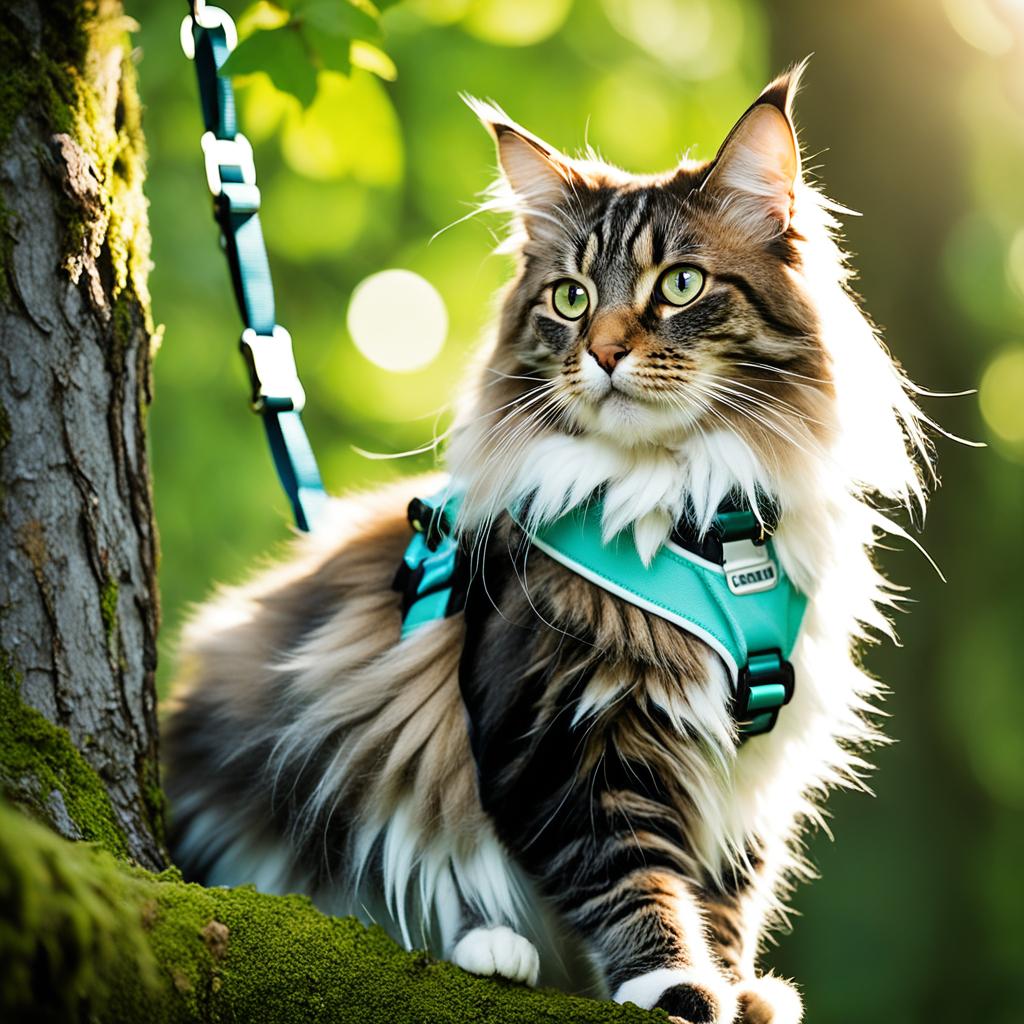
Embarking on the journey of Norwegian Forest Cat harness training can be a rewarding experience for both you and your feline friend. However, it requires consistency, patience, and a keen understanding of your cat’s unique personality and safety needs.
Patience and Consistency
When you’re figuring out how to train a Norwegian Forest Cat to use a harness, patience and consistency become your best allies. Cats are creatures of habit and introducing new elements into their routine takes time. Begin with short sessions where your feline simply wears the harness indoors, rewarding them with treats and affection to create positive associations.
Understanding Your Cat’s Personality
No two cats are the same, and understanding the idiosyncrasies of your Norwegian Forest cat is crucial in the training process. Observe how your cat reacts to the harness – some cats are naturally more accepting, while others may need a gradual introduction. Tailoring your approach based on their personality can facilitate smoother Norwegian Forest Cat harness training and lead to better results.
Safety First
Ensuring safe cat leash training is paramount. Always choose a harness that fits snugly yet comfortably, and never leave your cat unattended while harnessed. This prevents accidents and makes the overall training process safer for your furry explorer. Remember, a well-fitted harness significantly reduces the risk of escape or discomfort, contributing to a positive harness training experience.
Introducing the Harness to Your Cat

When teaching a cat to wear a harness, gradual introduction is key. Start by simply placing the harness near their favorite play area. This way, your Norwegian Forest Cat can investigate and become comfortable with its presence.
Familiarizing cats with harnesses involves letting them sniff and inspect the harness on their own terms. You can boost their curiosity and positive association with a little help from some tasty treats. Scatter a few near the harness and watch as they begin to approach it with interest.
Next, elevate the game by positioning the harness beside your cat when they’re in a relaxed state. Imagine your cat lounging on their favorite spot and the harness resting next to them, just waiting to become their next big adventure companion. Eventually, you can proceed to lightly drape the harness over your cat without fastening it. This step-by-step approach ensures positive reinforcement in harness training, creating a stress-free experience for your furry friend.
Remember, the most effective way in teaching a cat to wear a harness is through patience, treats, and a lot of love. Every time your cat shows calm and acceptance towards the harness, offer a reward. This will help in solidifying a positive connection with the harness and preparing for a smooth transition to the next stages of training.
- Place the harness near the cat’s play area.
- Encourage positive interaction using treats.
- Gradually move the harness closer during relaxed times.
- Lightly drape the harness over the cat without fastening it.
Getting Your Cat Comfortable With the Harness
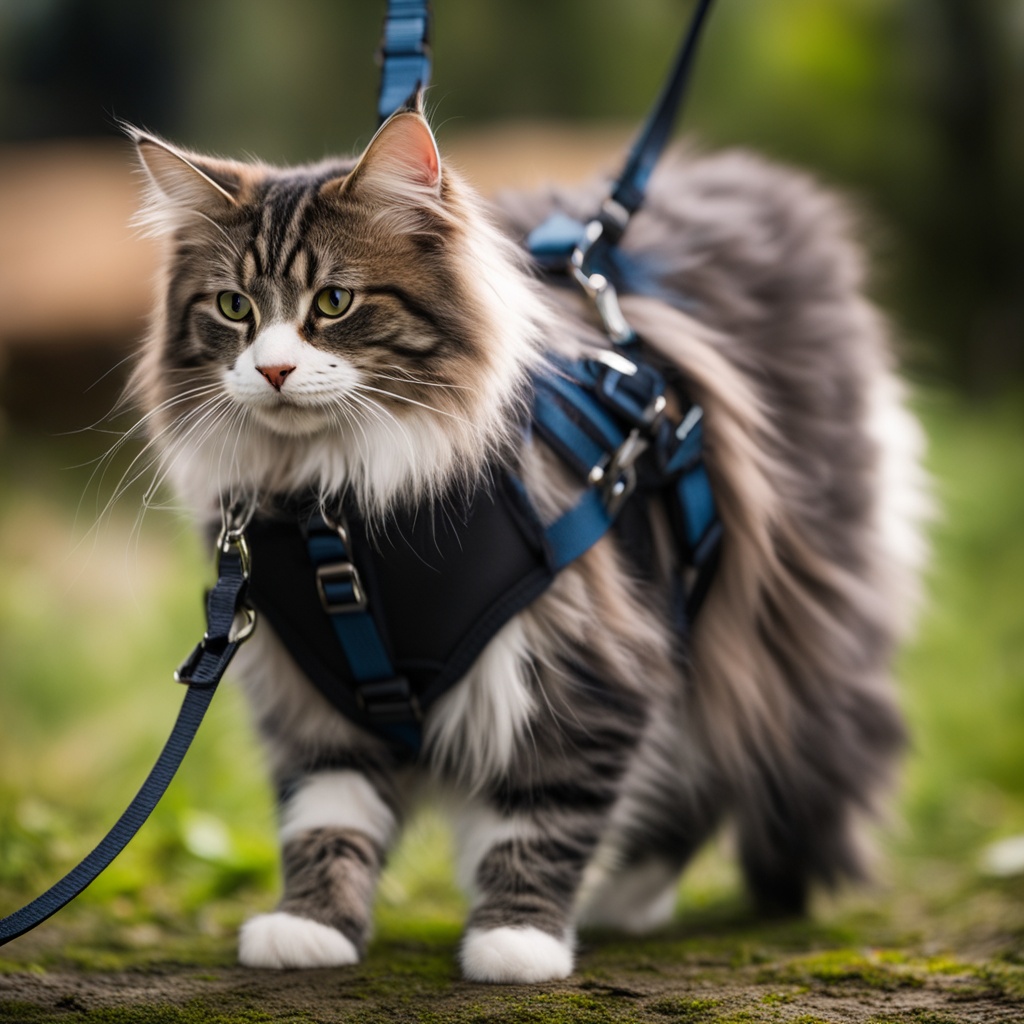
Your Norwegian Forest Cat will soon strut like a pro in their new harness with the right approach. Let’s delve into some effective cat harness training steps designed to make this transition smooth and enjoyable.
Positive Reinforcement Techniques
Rewarding a cat during harness training is crucial. The idea is simple: every time your furball shows even a hint of cooperation, shower them with affection, treats, or both. Positive reinforcement makes your cat associate the harness with delightful experiences, thus reducing anxiety and resistance.
Using Treats and Rewards
It’s treat-o-clock! Using treats and rewards is a proven strategy. Whenever your cat tolerates the harness or even shows curiosity about it, offer a small but irresistible treat. This method of rewarding a cat during harness training can work wonders, reinforcing good behavior effectively.
Short Indoor Sessions
Start with indoor harness training for cats to create a controlled environment where your feline feels safe. Keep the sessions short and sweet. Let your cat wear the harness during fun activities like playing with their favorite toy or nibbling on their dinner. Gradually increase the duration as your cat gets more comfortable.
| Training Step | Description | Benefit |
|---|---|---|
| Familiarization | Let the cat sniff and explore the harness at their own pace. | Reduces initial fear and curiosity |
| Positive Reinforcement | Reward your cat with treats and affection when calm around the harness. | Builds positive associations |
| Short Sessions | Start with brief indoor periods of wearing the harness during enjoyable activities. | Gradual adjustment to wearing the harness |
Attaching the Leash and Taking First Steps Indoors
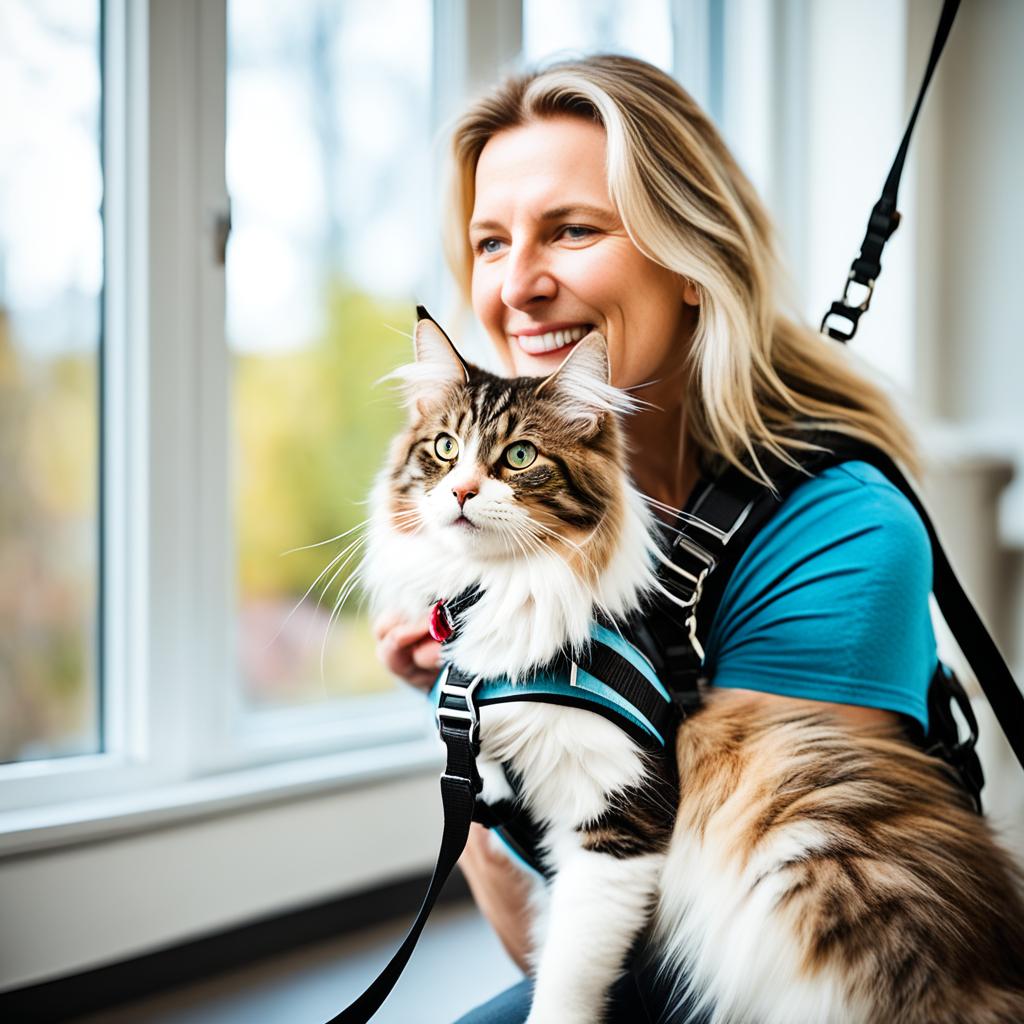
Starting with cat leash training tips involves introducing the leash in a low-pressure manner. Secure the leash to the harness while your cat is indoors. This cautious approach ensures the cat becomes familiar with the new sensation, using its innate curiosity to its advantage.
Allow your cat to drag the leash around, giving them the chance to adjust to its weight and movement. It’s important the leash remains loose; this avoids creating tension, allowing for a sense of independence which is crucial in indoor leash training for Norwegian Forest Cats.
Encouraging exploration and movement while the harness and leash are on can be achieved through play and the use of treats. These elements make introducing leash to cats a more enjoyable experience, fostering positive associations with the harness and leash.
As your cat begins to exhibit comfort and confidence indoors, you can gradually extend the duration of each session. This progressive method supports their adaptation, providing a sound foundation for future outdoor adventures.
Venturing Outside: The First Walk
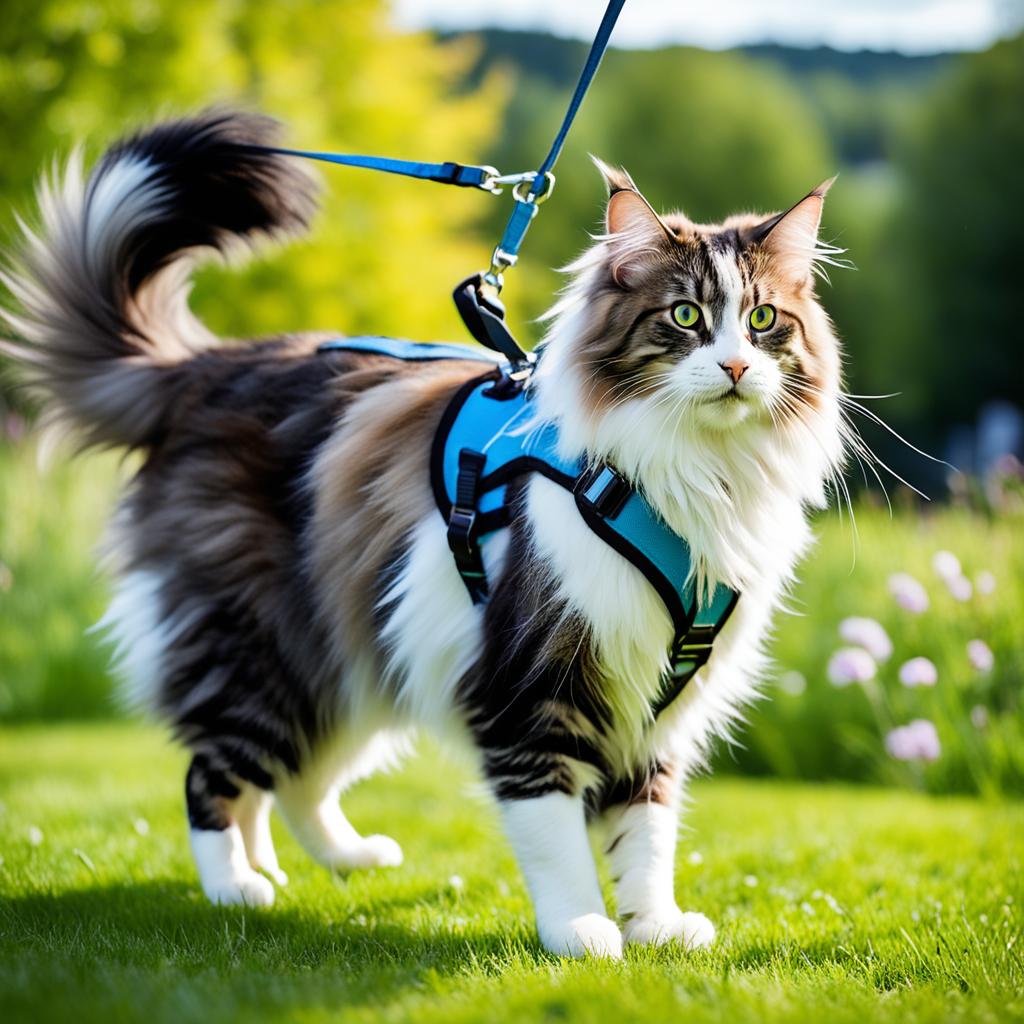
Taking your Norwegian Forest Cat out for its first outdoor walk can be an exhilarating experience for both you and your feline friend. This section provides tips on making this initial adventure as smooth and enjoyable as possible.
Choosing the Right Time and Place
When planning the first outdoor walk for harness-trained cats, timing and location are crucial. Opt for a quiet and safe environment, such as a backyard or a low-traffic park, to minimize stress. Avoid peak hours when distractions like traffic, pedestrians, or other animals could overwhelm your cat.
Managing Outdoor Distractions
Outdoor distractions are inevitable, but they can be managed effectively. Norwegian Forest Cat outdoor training requires you to be observant and proactive. If your cat seems startled by new sights or sounds, offer reassurance through gentle words and treats. This creates a positive association with the new environment.
Gradual Exposure to the Outdoors
Gradual exposure is key to a successful first outdoor walk. Start with short, manageable outings and progressively extend the duration as your cat becomes more comfortable. Allow your cat to explore at its own pace, and be patient if it seems hesitant. By managing your cat’s outdoor harness experience thoughtfully, you can ensure a stroll filled with curiosity and excitement rather than fear.
Common Challenges and How to Overcome Them
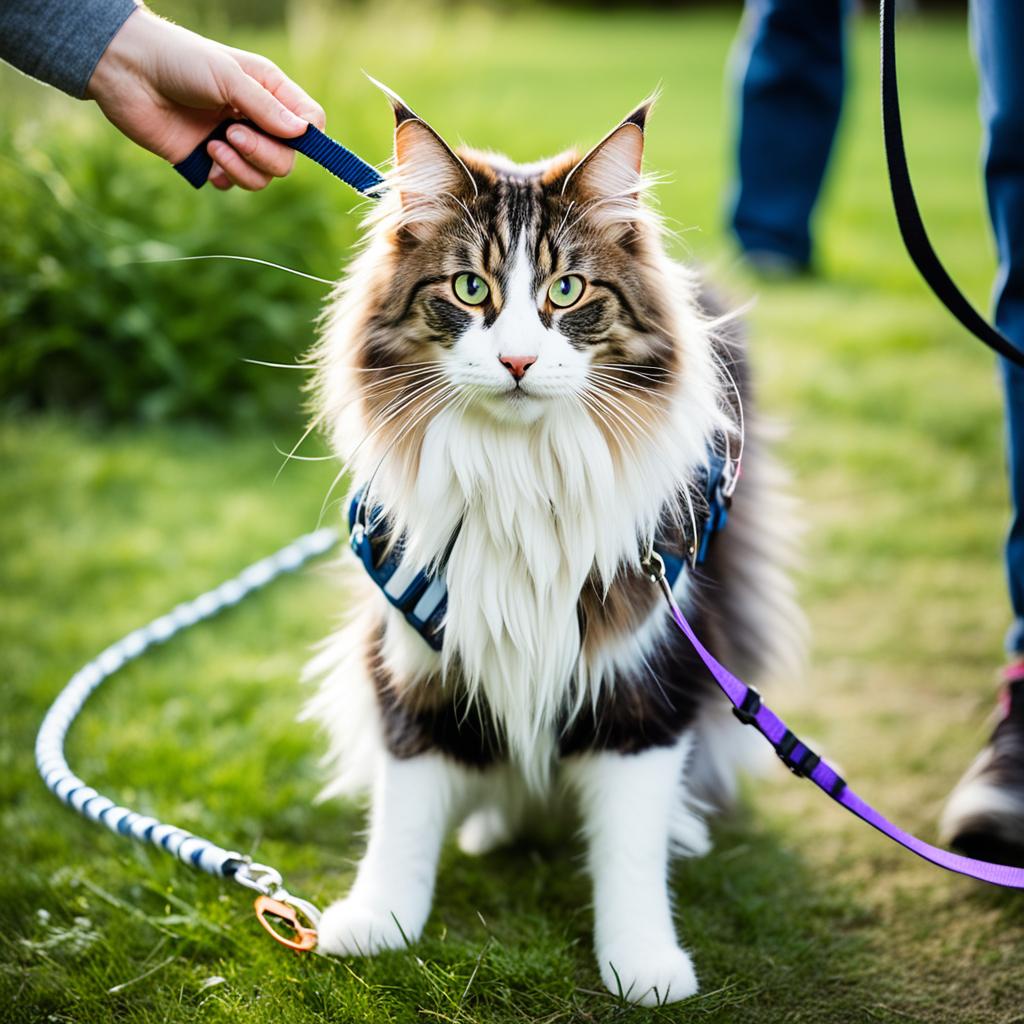
Training your Norwegian Forest Cat to wear a harness can be quite the adventure, filled with trials and triumphs. Let’s dive into some common difficulties you might face and how to tackle them effectively.
Dealing With Resistance
Resistance is a natural part of the Norwegian Forest Cat harness training process. To overcome this, gradually introduce the harness during playtime. If your furball refuses to budge, enticements like treats and their favorite toys can work wonders. Remember, persistence, patience, and positive reinforcement are your best friends here.
What to Do If Your Cat Becomes Distressed
No matter how well you plan, there may be times when you need to address your cat’s distress during harness walks. If your feline friend shows signs of anxiety, remain calm and offer gentle reassurances. Sometimes, retreating to a familiar environment for a bit can lower stress levels. Always monitor their body language closely for any signs of stress or discomfort.
Handling Outdoor Threats
Embarking on outdoor adventures? Stay vigilant for potential hazards. Dealing with outdoor threats like unleashed dogs or unexpected stimuli can be nerve-wracking for both you and your cat. Keep a watchful eye on your surroundings and be ready to pick up your cat or move to a safer area swiftly.
Here’s a quick guide to keeping your cat safe:
- Stay alert for potential hazards.
- Always have an escape plan.
- Encourage exploration in a controlled manner.
Maintaining Control and Ensuring Safety
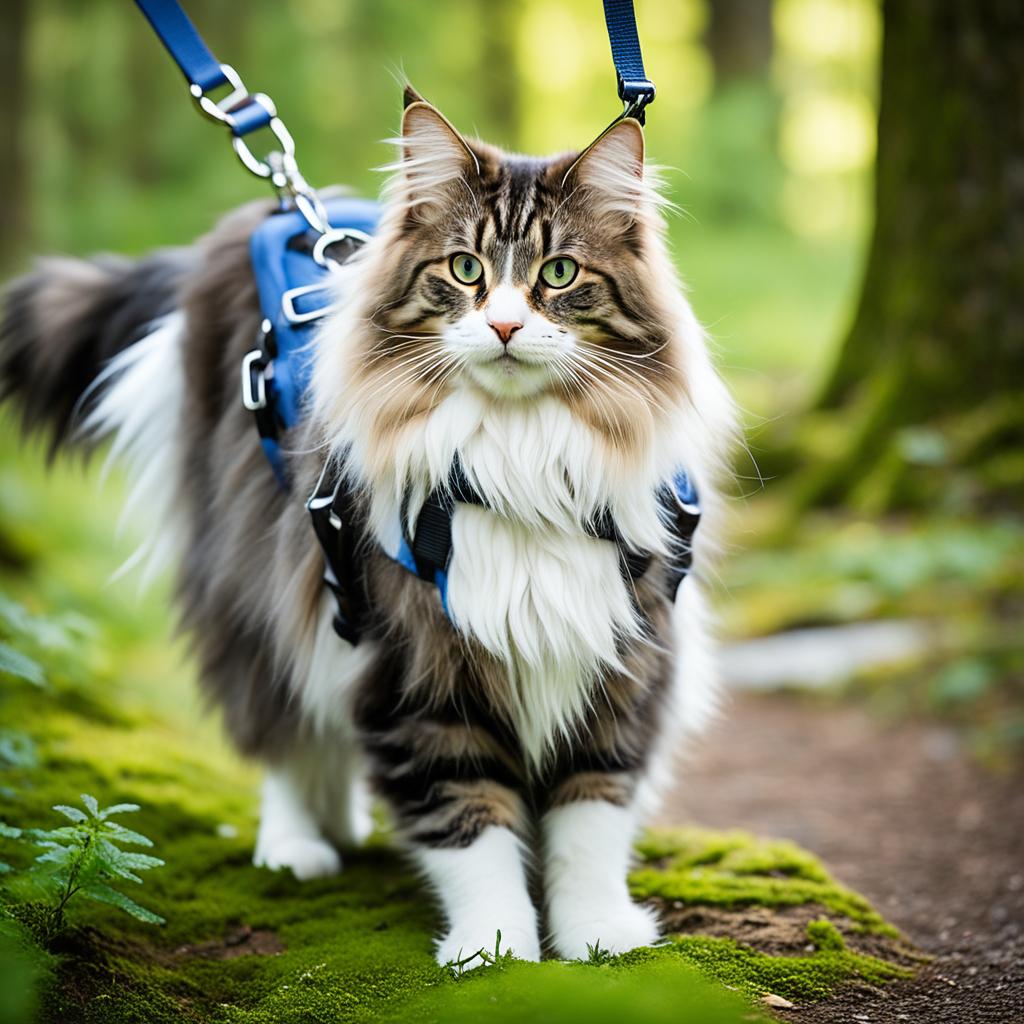
Maintaining control during cat walks is pivotal for ensuring harness training safety for cats, especially for the majestic Norwegian Forest Cats. Selecting the right leash and harness setup is fundamental. A good leash allows you to gently guide your feline friend without exerting undue force. Regularly check the harness fit to prevent escapes and inspect it for wear and tear to maintain safety during your adventures.
Tip: Ensure the harness fits snugly so you can fit 1-2 fingers between the harness and your cat.
Vigilance is key. Always be aware of your surroundings, watching out for potential hazards like traffic or aggressive animals. This awareness helps in maintaining control during cat walks and ensures your furry friend remains safe and sound. Proper harness fit, gentle guidance, and environmental awareness epitomize safe leash and harness practices for Norwegian Forest Cats.
Creating smooth and safe walking experiences will not only boost your cat’s confidence but also deepen the bond between you and your Norwegian Forest Cat. By adhering to these practices, you’ll master the art of harness training safety for cats and enjoy the great outdoors together.
Conclusion
The journey of Norwegian Forest Cat harness training can be incredibly rewarding, paving the way for safe outdoor adventures and enriching the lives of both you and your feline friend. This training not only allows your cat to explore the great outdoors safely but also provides essential mental and physical stimulation that contributes to their overall well-being.
Achieving successful cat leash training involves patience, consistency, and a deep understanding of your cat’s unique personality. By gradually introducing the harness and using positive reinforcement, you create a positive association that makes the experience enjoyable for your pet. Remember, the key to achieving safe outdoor experiences with cats lies in the meticulous attention to their comfort and safety throughout the process.
Embrace the journey of harness training your Norwegian Forest Cat; it’s more than a means to an end. Each step strengthens the bond you share with your furry companion, turning ordinary walks into extraordinary shared experiences. So, gear up and soak in the enriching journey that brings you closer to a life full of safe and stimulating outdoor adventures with your beloved cat.




